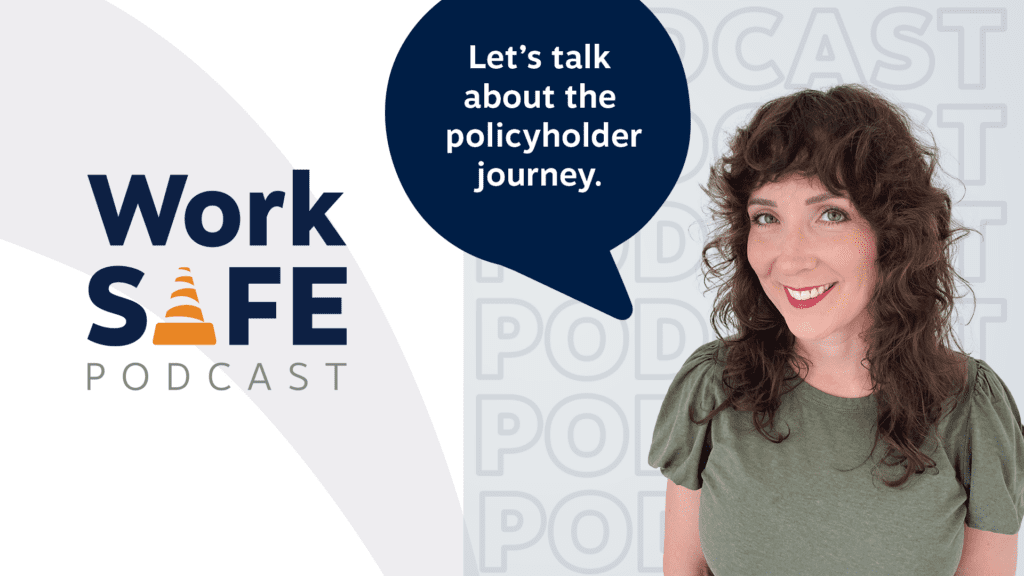On this episode of the WorkSAFE Podcast, we sit down with Lacey Hahn, Customer Engagement Strategist at MEM, to discuss the policyholder journey.
If you’re a business owner, you know that workers compensation isn’t just a policy. It’s a tool to protect your employees and your bottom line. But what happens after you receive your policy? How can employers control work comp costs and set themselves up for a smooth renewal at the end of the year?

Listen to this episode of the WorkSAFE Podcast, or read the show notes below.
Onboarding: The policyholder journey begins
For many employers, getting a work comp policy may be a new experience. Their policy secures them coverage, but…what happens next?
Once a customer decides MEM is the right fit, an onboarding process begins. Policyholders receive helpful tools and resources, and a walkthrough of what to do if a workplace incident happens. First-time policyholders are directed to the Policyholder Checklist, which serves as a comprehensive guide—a roadmap—to navigating areas like billing, claims, and finding the right safety solutions.
This checklist is also accompanied by an email series. Over five emails, MEM breaks down the important elements of work comp. The goal is to ensure new policyholders feel confident and comfortable navigating this new process.
Where do I access resources?
Policyholders have access to various resources, each designed to help them create a culture of safety and clarify the work comp experience. “We have an entire library of resources on our website,” Hahn shared. A visit to the MEM website provides access to:
- The Resource Library. Find free resources, including posters, Tool Box Talks, and sample safety policies.
- Program information. Policyholders can take advantage of different programs, such as Safety Grants, Nurse Aid, and endorsed safety solutions.
- Answers to frequently asked questions (FAQs). Each section answers commonly asked questions around topics like billing, audits, and injured workers.
“We really create these tools and guides specifically to help our policyholders through their entire work comp journey, so it’s just a vast library of checklists and guides and training materials. There’s something there for everyone,” she said.

Policy management: Finding the right programs for you
Once onboarding is complete, a new phase begins. “Once you’re comfortable, we’ll move into a management phase,” Hahn shared. “That’s really where we partner with policyholders. We’re all about preventing injuries and helping you become a pro at workplace safety.”
Employers get support when and how they need it. MEM’s Safety and Risk Services team can help minimize workplace risk through a visit and thorough assessment. They give safety tips, point employers to further resources, and help develop custom training plans.
The MEM Safety Grant program is also an option for addressing safety solutions that have a higher price tag. A Safety Grant provides a one-to-one matching investment in a safety initiative, doubling a company’s investment. Employers can apply any time, and decisions are made by the following month. In the nearly nine years since its inception, more than 400 grants have been awarded to different businesses.
Claims: Navigating a workplace incident
Building a safety culture and reducing risk in the workplace helps prevent incidents. But when they do occur, MEM has a team ready to assist. Several people will join you during your claim process. In-house claims professionals quickly coordinate with medical teams and provide updates in the event of an injury. Hahn often refers to the Claims Management Kit as an essential resource for policyholders.
“We think of it as your ‘Oops, something happened!’ guide,” she explained. “It breaks down everything. It goes through when to go to the ER versus calling our nurse triage line, a quick checklist for figuring out what happened, and then all the forms that you might need to fill out – it just kind of flows through the claims process. It’s great.”
Renewal: Setting up for the next policy year
At MEM, policies follow a yearly cycle. Renewal communication starts a month or so before a policy ends. Premium is calculated using different factors: payroll, experience modification factor (e-mod), and state-dependent rates. Employers get insight, ahead of renewal, as to what the next year’s cost may be.
An audit takes place, where actual costs for the year are determined and estimated costs for the next year are calculated. Members of MEM’s Premium Consultation team step in to help policyholders understand what documents and forms are required to do this. They may ask important questions, like:
- Have you hired any new team members? Did anyone move on, reducing your total number of employees?
- Are you offering any new services? If so, what kind of work are your employees doing now?
- Are you moving from year-round work to only offering seasonal services?
Agents often play a key role in the renewal process. “If any of those things have changed, it’s really important to give your agent a call,” Hahn pointed out. “They can make sure your policy is up to date and reflects how your business is running right now. That way, you know you’re fully covered.”
The purpose of an audit is to ensure that policyholders are paying accurate premiums. “We follow rules set by the National Council on Compensation Insurance and state regulators,” Hahn explained. “So, at the end of your policy period, we do audits to make sure you’re paying the right amount.”

The policyholder journey: Tap into resources that are created just for you
For Hahn, a policyholder’s biggest asset is all of the tools designed to help them. Missing out on them means missing out on value. “You know, it’s almost like if you bought a new gadget and you never read the manual. You’re missing out on all these really cool features – that’s how I see our resources,” she shared. “They’re available to make your life easier, to help prevent incidents, and to really understand your policy.”
Policyholder feedback is essential to creating impactful tools and resources. Hahn encourages policyholders to fill out surveys as they arrive throughout the policyholder journey.
“If there’s something that we try out, or you have an idea about how something could be better, we also want you to tell us about that,” she finished. “We want to know how we can make these resources work even better for you, because at the end of the day, that’s what it’s all about for us.”